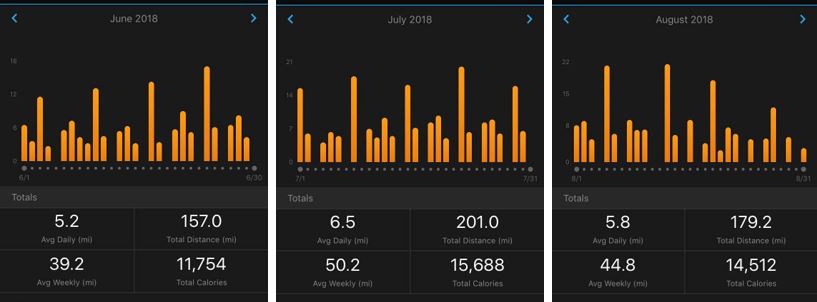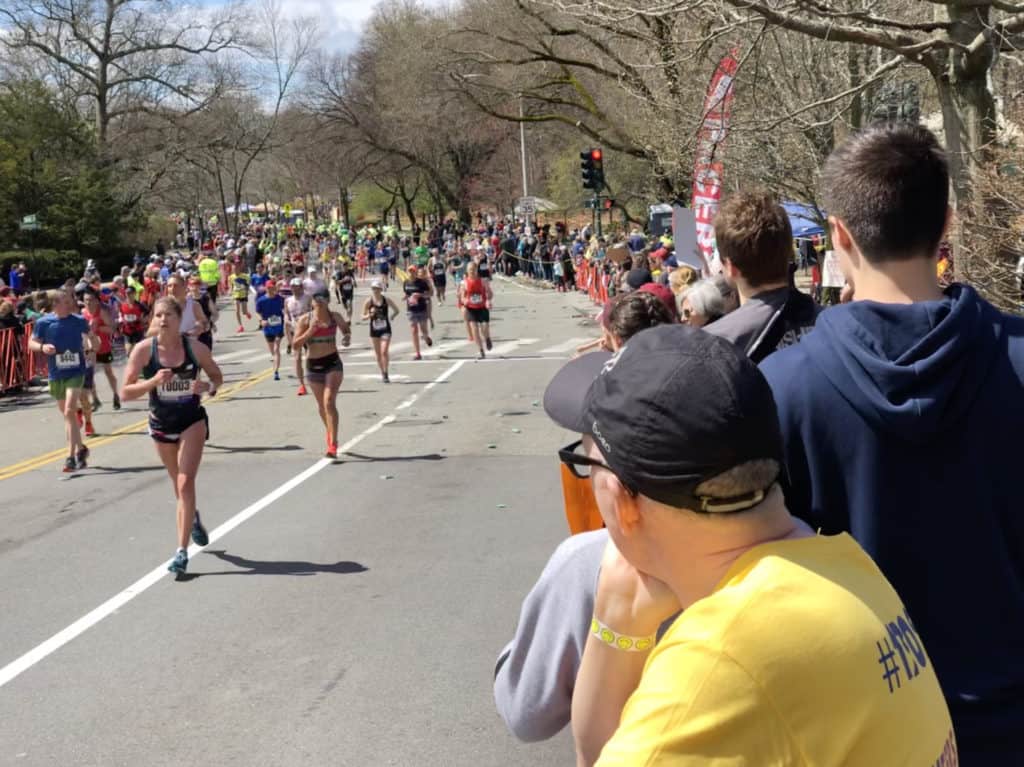If you are new to marathon training, “cumulative fatigue” or “accumulated fatigue” might be a term that you hear runners talk about or something you might see as part of your training plan. You might be thinking that sounds less than desirable, but in marathon training, it’s actually a good thing. Hmmm…how could fatigue…that accumulates…be something good? As a runner who has earned marathon PRs by increasing mileage with a goal this year to top my last training cycle’s mileage, I wanted to know more about why cumulative fatigue is an important part of the training. I’ll also explain what it is and how it happens.
So, what is cumulative fatigue? Cumulative fatigue refers to building up running mileage over time through various types of running. With only one rest day per week, the overall feeling of fatigue of running 45-60 plus miles per week is unavoidable. The goal is to reach a peak of cumulative fatigue a few weeks before it’s time to race your marathon. It’s one of the best ways to prepare you for race day.
With proper marathon training that utilizes cumulative fatigue (a great way to think of this is running on tired legs), you can prepare to power through the most grueling stages of the marathon.
How to Build Cumulative Fatigue in Marathon Training
Going into marathon training, you should already have a solid base of running. Ideally a minimum of 15-20 miles a week. So as you begin your marathon training, you’re probably not going to feel too sore during your runs and you’ll probably enjoy the first couple of weeks easing into increasing miles. It may not even be that far off from the mileage you were running previously.
Where cumulative fatigue begins to set in is closer to the second month. It basically continues until your taper, so hold on for the ride. Marathon training isn’t supposed to be comfortable…just keep reminding yourself that if it were easy, everyone would do it.
What is cumulative fatigue exactly?
With cumulative fatigue, you are learning to complete your runs on tired legs. Instead of allowing yourself full recovery before your next run, you continue to run even when your body is sometimes wishing you would just give it a break. It is often associated with the Hanson method of marathon training. However, cumulative fatigue can occur in any high mileage training program.
The goal of cumulative fatigue is to never rest enough to let your body fully recover. Rest days will only happen 1 or 2 times per week when training this way. The best marathoners usually only have one full rest day per week. I’ll talk more about why that’s important for your marathon in a minute.
But here’s what cumulative fatigue during training can look like from a workout perspective:

The above pictures show my marathon training mileage for months 2, 3, and 4 from the summer of 2018. My peak mileage happened mid-August (about 55 miles in one week) which was 3 weeks before my Labor Day marathon. (I was also going to Orange Theory Fitness once per week on the same day as one of my shorter runs.)
The end of August included a taper period (where a runner decreases mileage in preparation for their race), which is why July is the heaviest month of miles. 201 miles in one month will seem daunting to someone who has never run a marathon, and you don’t have to be that high to build cumulative fatigue. Though I do personally think reaching 60 mile-weeks is the sweet spot for a lot of runners, and that’s what I’m aiming for in my current training cycle.
This was far from easy, folks! There were days I wished I could skip a run, but I knew it mattered that I kept pushing through.

How Cumulative Fatigue Helps You in Your Marathon
So all those miles up there? The truth is that it.got.hard. I often questioned on those Saturday long runs how I was possibly going to make my goal marathon time with how uncomfortable even my easy pace sometimes seemed. But that’s the point. If you never learn to run through the uncomfortable or learn how to run on tired legs, you won’t be ready for your marathon. Remind yourself that you are getting fit and strong.
Experiencing cumulative fatigue can sometimes make you want to just hit snooze and skip your run. Yes, you will be tired. And I guarantee you’ll be tired when you near the end of your marathon, and more so if you start skipping runs. Don’t do that.
By training in a way that creates cumulative fatigue over the course of weeks and months, you are preparing not only your body but also your mind, to keep going even when your legs are trying to tell you, “hell no.” This is why getting to a point of high mileage is so important.
Once you get to marathon race day, you’ll find you can hang on pretty well for those first 18-21 miles. You’re thinking, “Hey, this isn’t so bad!” Then wham!! Out of nowhere, you’re convinced you’re using cement blocks to run with instead of your legs. A major part of this comes from a glycogen deficit that I talk about in my article, “What’s the hardest mile of a marathon?” It also pertains to a lack of cumulative fatigue training.
Training to a point where you experience cumulative fatigue doesn’t make you immune to the dreaded “wall” that occurs around this mileage point. It doesn’t make the fatigue go away that you are sure to feel towards the end of a marathon.
What it does do is allow your body to know what it’s like to need to power through. And learning to run on tired legs without full recovery gives way to great gains on race day when you finally get to run on fresh legs.
Since cumulative fatigue means that you can still complete your training runs as prescribed even when your body feels less than stellar, this will not be a new feeling for your body as you try to continue your pace through the end of your marathon. And psychologically? This matters, too. Your mind gives in before your body will, and if you haven’t trained your mind to tell your body to keep moving even when you want to quit, it’s probably not going to suddenly happen on race day.

But I’ve seen marathon training plans where I only run 3-4 days per week!
Though you could technically train for a marathon in 3-4 days per week, it’s really not ideal for most runners who want to reach their potential. Can you run a marathon training less than 5 days per week? Sure you could. In fact, this “less is more” plan is an example of a training plan that encourages you to do so. This particular plan, however, does have you complete 2 additional hard cross-training days, so you would still be reaping some benefits of fatigued training. Though I wouldn’t try this plan personally and it wouldn’t be my recommendation, for some who are more prone to injury this could be something to try.
On the other hand, if you are really only running 3-4 days per week with the other days being rest days, you won’t reach your marathon potential. Yes, your runs will probably feel great! You’ll probably hit your speedwork goals easily and your long run easy pace won’t ever seem difficult. But you might find that your longest runs get tough to get through near the end, and the last 10k of the marathon – as short as it may seem in the grand scheme – could send your marathon time spiraling down the tank. Take it from me – that is not ever a fun way to finish a race. I did exactly as I described in my 2 marathons I ran in my 20s and it made me quit the marathon distance for the next 10 years.
Cumulative Fatigue is Different From Overtraining
So how can you spot the differences between normal cumulative fatigue and overtraining?
Whereas cumulative fatigue is a good thing and something you’re going for in marathon training, overtraining isn’t. Overtraining means you’re not in a healthy state of mileage and you are setting yourself up for overuse injuries. When you run too many miles or incorporate too much speedwork too soon, you put yourself at risk of overtraining. Here are the signs to look for so that you know the difference.
Cumulative Fatigue – what it feels like:
- builds up over time
- is a constant feeling over weeks and months
- some tiredness is normal, but you can still maintain desired paces
- your body is still able to adapt
Overtraining – what it feels like:
- cramping and soreness that shows up more suddenly
- decreased performance
- unable to meet workout goals (can’t finish runs, can’t hit paces in speedwork)
- acute injuries such as pulled muscles and aching joints
- weakened immune system
- you constantly feel “behind” your goals
Utilizing a proper training plan where mileage is slowly built up over 18 weeks or more will help avoid overtraining. However, it can still happen as everyone is different. Though skipping workouts is not ideal for building cumulative fatigue, you also need to take care of yourself. If you have any of the overtraining signs listed, be smart by taking an extra day or two to rest. You can still gain some cumulative fatigue build-up by doing another cardio exercise in place of running.
Getting Through Your Runs Without Suffering
I know it might sound like a lot. Especially if you are just diving into this marathon world and getting started. But my advice is to take it one week at a time. Look ahead at the beginning of each week and map out when and where you will accomplish each run. This makes it so much more manageable. It will quickly become part of your routine and you won’t even want to miss your run once you make it a habit.
When training properly for a marathon, body and mental fatigue are normal. Here are a few other tips for staying as comfortable as possible through all your weeks of running and with a smile on your face. (You can also read my article, “How to Overcome Running Fatigue” for more in-depth information about each of these.)
- Sleep Enough – if you want to know how important sleep is in training, you’ll want to read my article “How Sleep Can Give You the Edge You Need In Marathon Training.” In a nutshell – it’s important, and you need more than you’d think.
- Eat Well – Proper nutrition is another big part of your marathon training. You need to fuel properly before, during, and after your runs. This means getting the proper balance of macronutrients – carbs, protein, and fat. Don’t stress yourself out on being perfect, but do take away some key elements from this article from Runner’s Connect.
- Hydrate, hydrate, hydrate – you’ll need more water than you’ve probably ever needed before. Sip throughout the day and be sure to bring enough water for your runs. You’ll also need electrolytes either through your hydration or nutrition.
- Stretch – Before and after each of your runs. Foam rolling is an excellent way to get deeply into fatigued muscle tissue that comes from so much running mileage. Here is a great guide to foam rolling.
- Mix it Up – Break up the monotony in your runs by going somewhere new, meeting up with friends, listening to new music, etc. One way I do this is by going to Orange Theory Fitness once or twice per week. I am almost always alone when I run, so it’s fun to workout in a faster-paced environment surrounded by others who are working hard, too.







